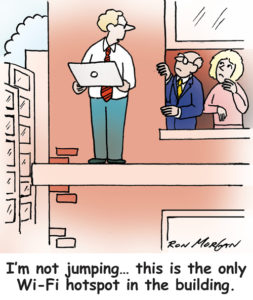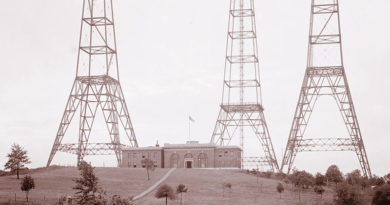WhyFi
By The Phantom
Sometimes standards bodies anticipate needs and develop standards, and nobody comes to the party. That’s one of the hazards of standards development. Standards are almost always developed by volunteers from companies who are interested in products based on the standard, and those companies spend a lot of money on top engineers working on the standard. So there has usually been a reasonable amount of market research that has gone into the standard before the development process. But marketing is hardly an exact science.
Other standards are successful beyond the wildest dreams of their developers. Such is true of the IEEE’s 802.11 series of standards, commonly known as Wi-Fi. Once people understood what it could do for them, and volume got high enough for prices to come down, it took off like a politician after money. Most of the cable modems we use today have Wi-Fi built in. But with this success has come a number of headaches, both for us and for our subscribers.
Those of you who have worked only in cable RF think you have a lot of issues with RF (you do). Those of us who have released RF signals into the wild ether know even more issues! Signals can be reflected and cause problems (though modern Wi-Fi has a number of tools to automatically deal with reflections). Signals can fail to reach the receiver. On the other hand you can get too much signal to a receiver and overload it. Or a number of signals can reach a receiver on different frequencies and cause interference — you remember CTB and CSO? Well the same distortions exist in off-air receivers. When you have unregulated signals such as Wi-Fi, you can get too many in a small area, and they can interfere. Wi-Fi has a number of features to let different Wi-Fi networks operate on the same frequency, but they all involve time-sharing the frequency, so if you get too many signals, performance can suffer. We call all of these problems collectively, “perils of the radio path.”
 We recently visited a friend who lives in a large apartment building. She complained of slow data service from her cable operator. A tech had been to her apartment and found her modem to meet the speed she had bought. But she wasn’t getting that speed. We took a look at the Wi-Fi environment, and our device could only display the first 20 or so Wi-Fi networks in her apartment! No wonder she had problems. The 2.4 GHz band is the most popular Wi-Fi band. You’d think that with the 11 channels in the band, that you could accommodate many Wi-Fi networks. But the catch is that those channels overlap. There are only three channels that don’t overlap, channels 1, 6, and 11, not to mention the plethora of other devices that use the same band; the FCC has said, “meet these minimal rules and have fun at 2.4 GHz.” There is a 5 GHz band that is not as crowded, and there is talk of opening other bands to Wi-Fi, so there is some help. But that does not do you any good as your phone system is hot with complaints of lousy data service, when the root cause is perils of the Wi-Fi radio path.
We recently visited a friend who lives in a large apartment building. She complained of slow data service from her cable operator. A tech had been to her apartment and found her modem to meet the speed she had bought. But she wasn’t getting that speed. We took a look at the Wi-Fi environment, and our device could only display the first 20 or so Wi-Fi networks in her apartment! No wonder she had problems. The 2.4 GHz band is the most popular Wi-Fi band. You’d think that with the 11 channels in the band, that you could accommodate many Wi-Fi networks. But the catch is that those channels overlap. There are only three channels that don’t overlap, channels 1, 6, and 11, not to mention the plethora of other devices that use the same band; the FCC has said, “meet these minimal rules and have fun at 2.4 GHz.” There is a 5 GHz band that is not as crowded, and there is talk of opening other bands to Wi-Fi, so there is some help. But that does not do you any good as your phone system is hot with complaints of lousy data service, when the root cause is perils of the Wi-Fi radio path.
It would be helpful to have Wi-Fi modems report back to you what their problems are, so that you can diagnose them remotely. But not all Wi-Fi is part of the cable modem — subscribers such as yours truly install their own, as well as using the one provided by our friendly cable operator. So we really need all Wi-Fi modems to report their difficulties using a common standard that your diagnosis gear can understand. Uh, remember those standards bodies we talked about earlier? How do you get them interested in the problem? First, talk to your cable modem vendor(s) and tell them what you need. Then every chance you get, talk to other Wi-Fi vendors. If enough of you do that, 802.11 will set up a working group to work on the problem. Then you need to make sure the MSOs are represented at the meetings (yes, you can go), to make sure that the solutions proposed are practical.
 The Phantom
The Phantom
the.phantom@youwontfindmeanywhere.com
You never know when The Phantom is standing right beside you. Sometimes he is in a meeting with you or walking the floor at your favorite cable show. Sometimes he’s hanging with the suits and other times with the front liners. But be assured, The Phantom sees all, The Phantom knows all and, most importantly, The Phantom tells all.
Cartoonstock.com



